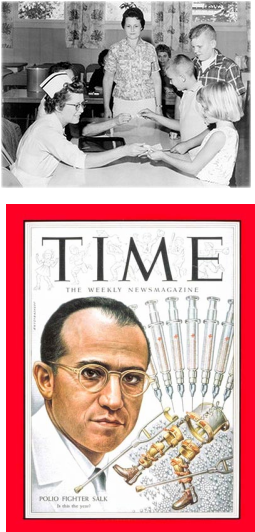The Vaccine

Jonas Salkstudied viruses, such as influenza, and ways to vaccinate against them. The basic idea of vaccines are simple: when diagnosed with a weaker form of a virus, it will produce antibodies to attack the virus and will make the body stronger. This will prepare the body for an invasion and will counterstrike the virus. In 1947, Salk became head of the Virus Research Lab at the University of Pittsburgh and started his first step in the prevention of polio.
In 1948, three scientists, J.F. Enders, T.H. Weller, and F.C. Robbins, made a breakthrough with their hard research. They found that the virus could grow on samples of tissue, without needing an intact organism. Bacteria usually contaminated the tissue, but Enders' team obtained penicillin and stopped the bacterial growth. Now viruses of all sorts could be created in large quantities for study. This team won the 1954 Nobel Prize in physiology/medicine. Now Salkcould speed up his research. Using formaldehyde, he killed the polio virus but kept it intact enough to trigger the body's response. On July 2, 1952, Salktried a new vaccine on children who'd already had polio. These children recovered while their antibody level had increased.Salkthen tested it on uninfected subjects including several members of his family. In 1953, Salk reported his findings in The Journal of the American Medical Association. A nationwide testing of the vaccine was launched in April 1954 with the mass vaccination of school children as they were the most prone. The results were amazing with 60-70 percent prevention and Salkwas glorified.
Things took a turn for the worse,however, when a report came out of over 200 cases of polio leaving 11 dead. Luckily, it was soon discovered it was the fault of a specific company's faulty production. Now it was assured the vaccine was safe and stricter supervision followed to assure the safety of all of the patients.
Albert Sabin, a Russian-born (now Poland) American scientist, felt that Salk's killed-virus vaccine was not strong enough. . He experimented with more than 9,000 monkeys and 100 chimpanzees to make a stronger form before isolating a rare form of poliovirus that would reproduce in the intestinal tract but not in the central nervous system. In 1957 he was ready for human trials of an oral vaccine. It was tested in other countries, including the U.S.S.R. and Eastern Europe. In 1958 other researchers tried to cast doubts on Sabin's "communist vaccine." In spite of this, his vaccine was licensed in 1962 and quickly became the vaccine of choice as it was cheaper to make and easier to take thanSalk's injectable vaccine.
In 1948, three scientists, J.F. Enders, T.H. Weller, and F.C. Robbins, made a breakthrough with their hard research. They found that the virus could grow on samples of tissue, without needing an intact organism. Bacteria usually contaminated the tissue, but Enders' team obtained penicillin and stopped the bacterial growth. Now viruses of all sorts could be created in large quantities for study. This team won the 1954 Nobel Prize in physiology/medicine. Now Salkcould speed up his research. Using formaldehyde, he killed the polio virus but kept it intact enough to trigger the body's response. On July 2, 1952, Salktried a new vaccine on children who'd already had polio. These children recovered while their antibody level had increased.Salkthen tested it on uninfected subjects including several members of his family. In 1953, Salk reported his findings in The Journal of the American Medical Association. A nationwide testing of the vaccine was launched in April 1954 with the mass vaccination of school children as they were the most prone. The results were amazing with 60-70 percent prevention and Salkwas glorified.
Things took a turn for the worse,however, when a report came out of over 200 cases of polio leaving 11 dead. Luckily, it was soon discovered it was the fault of a specific company's faulty production. Now it was assured the vaccine was safe and stricter supervision followed to assure the safety of all of the patients.
Albert Sabin, a Russian-born (now Poland) American scientist, felt that Salk's killed-virus vaccine was not strong enough. . He experimented with more than 9,000 monkeys and 100 chimpanzees to make a stronger form before isolating a rare form of poliovirus that would reproduce in the intestinal tract but not in the central nervous system. In 1957 he was ready for human trials of an oral vaccine. It was tested in other countries, including the U.S.S.R. and Eastern Europe. In 1958 other researchers tried to cast doubts on Sabin's "communist vaccine." In spite of this, his vaccine was licensed in 1962 and quickly became the vaccine of choice as it was cheaper to make and easier to take thanSalk's injectable vaccine.
